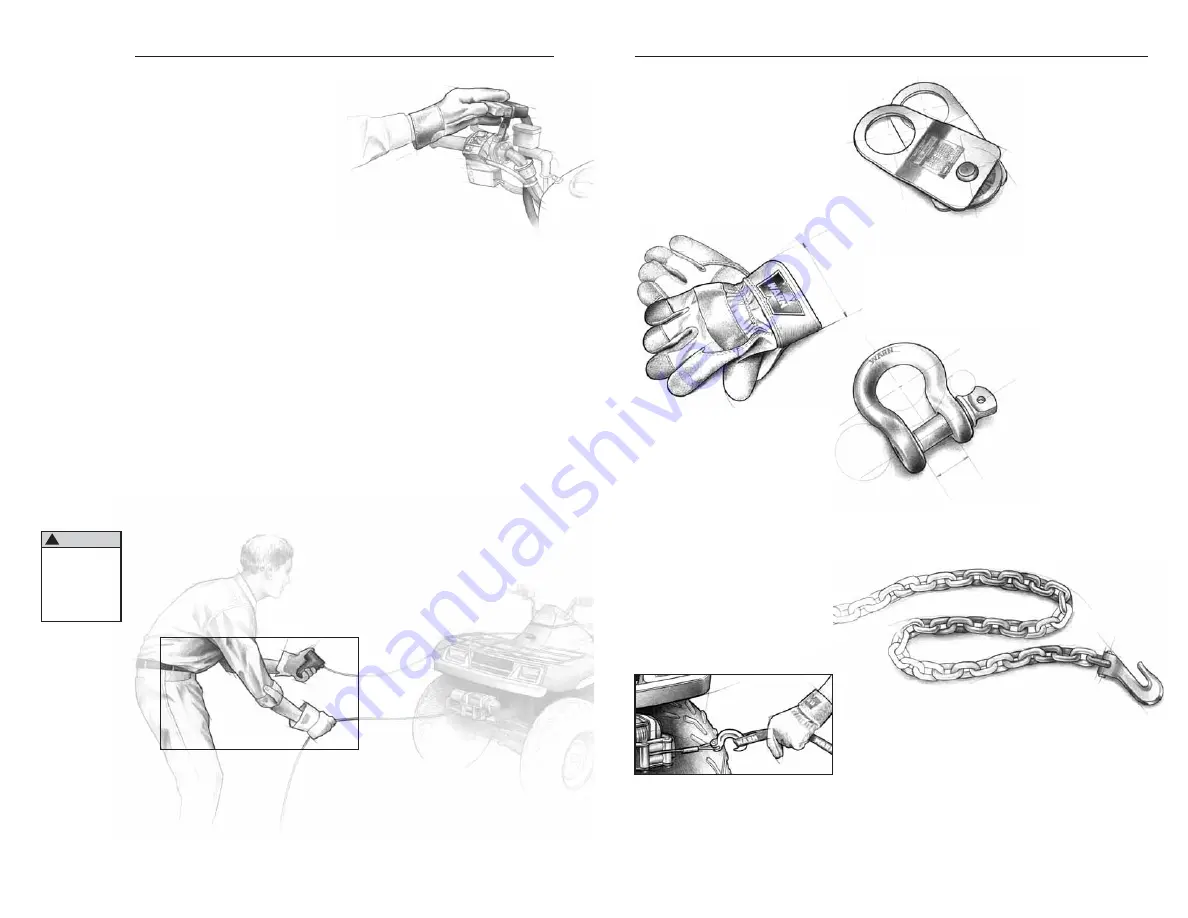
G O P R E P A R E D
™
9
WARN INDUSTRIES • THE BASIC GUIDE TO WINCHING TECHNIQUES
G O P R E P A R E D
™
8
WARN INDUSTRIES • THE BASIC GUIDE TO WINCHING TECHNIQUES
Gloves
rope, through use, will
develop “barbs” which can slice skin. It
is extremely important to wear protective
gloves while operating the winch or
handling the rope. Avoid loose fitting
clothes or anything that could become
entangled in the rope and other moving
parts.
Hook Strap
Use to hold the hook and
keep fingers away from the fairlead as
the rope is being spooled in. Winches
develop tremendous pulling forces and
can easily remove fingers and limbs that
are placed in pinch points. Put the hook
into the loop and hold the strap between
the thumb and forefingers.
Snatch Block
Used properly, the
multi-purpose snatch block allows you to:
(1) increase your winch’s pulling
power; and (2) change your pulling
direction without damaging the rope.
Proper use of the snatch block is covered
in “Before You Pull”.
Clevis/D-Shackles
The D-Shackle is
a safe means for connecting the looped
ends of cables, straps and snatch blocks.
The shackle’s pin is threaded to allow
easy removal.
Alone, the winch is not much more
than a simple tool. But when used with
certain accessories and enhancements,
your Warn winch can become a
versatile and productive tool. In this
section, we’ll review several of these
items. Some are vital to the safe
operation of your winch, while others
offer added versatility and convenience.
Choker Chain
Can be used to hook-
up to another vehicle or sharp objects for
an anchor point. Chains, however, will
damage or kill trees.
Rocker switch control
Winch Mechanics
Now that you’ve familiarized yourself
with your Warn winch and its
components, we can begin reviewing
how it works. The major advantage of an
electric-powered winch is that it can
provide reliable service for intermittent
utility and recreational use even while the
vehicle’s engine is stalled — assuming,
of course, that sufficient battery current is
available. Your winch can operate at high
current loads, and, for this reason, uses
a high current switch system to safely
handle the current flow.
It is important to understand that the
longer the pull, the more heat that is
created, just like a hot plate. Powering
out the rope also generates heat and
drains the electrical system. Whenever
possible, unwind rope by “freespooling.”
Prolonged winching without cooling the
winch motor will damage the motor. Also,
even if the engine is idling during
winching, the battery may drain faster
than it is charging. So pay close attention
to make sure you aren’t draining your
battery too low to start your vehicle.
Control Of Your Winch
The winch is controlled by a switch
mechanism that provides control of the
forward or reverse rotation of the
spooling drum.
How the Winch Reacts to Load
Warn winches are rated by pulling
capacity. The maximum pulling capacity
occurs on the first layer of rope on the
drum. As the layers increase, the pulling
power decreases. It’s the mathematics of
winching. Exceeding the winch capacity
could cause the winch to fail or the rope
to break. Thinking through how you
intend to use your winch now, could save
you a big headache later.
In addition, you’ll also want to make
sure that your winch’s mounting system
and your vehicle’s frame can accom-
modate the rated load of your winch.
This winch is
controlled by the
hand held remote
control to allow the
operator to stand
clear during the
winching process.
WINCH ACCESSORIES YOU’LL WANT TO HAVE WITH YOU
HOW THE WINCH WORKS
Always keep
vehicle in sight
during winching
operation.
!
WARNING



























